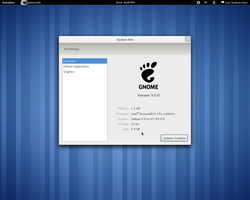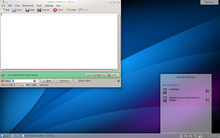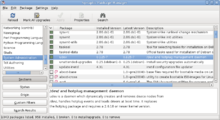This is an old revision of this page, as edited by ImperfectlyInformed (talk | contribs) at 23:48, 23 April 2013 (→Applications: unhide the package management article). The present address (URL) is a permanent link to this revision, which may differ significantly from the current revision.
Revision as of 23:48, 23 April 2013 by ImperfectlyInformed (talk | contribs) (→Applications: unhide the package management article)(diff) ← Previous revision | Latest revision (diff) | Newer revision → (diff) The GNOME desktop environment, a popular Linux desktop environment The GNOME desktop environment, a popular Linux desktop environment |
Desktop Linux, also called Linux on the desktop, refers to specialized Linux distributions with features designed for desktop personal computer users. These features include a graphical user interface and personal use applications.
Some Linux distributions have targeted the desktop role specifically, while others include all the software available for the platform. In that case, the user will be given the choice to select either a "desktop" or "server" type when the operating system is installed.
History
See also: History of free software § DesktopHistorically, UNIX and other Unix-like operating systems have been utilized on servers, mainframes, and workstations in corporate or scientific environments. Beginning in the late 90s, a few Linux distribution companies, such as MandrakeSoft, began to advertise their systems for low-end desktop computers.
Desktop environments

Linux offers many desktop alternatives. Common desktop environments include KDE, GNOME, Xfce, LXDE, Unity and Cinnamon. These are collections of desktop programs, rather than bare bones window managers such as FVWM, IceWM amongst numerous others. These environments present a GUI using a desktop metaphor. All of these environments allow the user to set many personal preferences and to perform common system management tasks. The Compiz window manager expands upon the concept of having multiple desktops by rendering each of the user's two dimensional desktops on the surface of a three dimensional cube. The variety of desktop environments is sometimes criticized for splintering focus and creating incompatibilities; the freedesktop.org project works on improving interoperability between the different environments.
All Linux desktop applications use the X Window System and thus benefit from features like networking (remote display) and quick mouse-only cut, copy, and paste. Mouse selected text is automatically copied, and it can then be pasted using a middle click, without the need to resort to use of the keyboard.
History and criticism
Main article: Criticism of desktop LinuxKDE was the first advanced desktop environment, but it was controversial due to the proprietary Qt toolkit used. GNOME was developed as an alternative due to licensing questions. The two use a different underlying toolkit and thus involve different programming, and are sponsored by two different groups, German nonprofit KDE e.V. and the United States nonprofit GNOME Foundation.
As of April 2007, one journalist estimated that KDE had 65% of market share versus 26% for GNOME. In January 2008, KDE 4 was released prematurely with bugs, driving users to GNOME. GNOME 3, released in April 2011, was called an "unholy mess" by Linus Torvalds due to its controversial design changes.
Dissatisfaction with GNOME 3 led to a fork, Cinnamon, which is developed primarily by Linux Mint developer Clement LeFebvre. This restores the more traditional desktop environment with marginal improvements.
The relatively well-funded distribution Ubuntu designed (and released in June 2011) another user interface called Unity which is radically different from the conventional desktop environment and has been criticized as having various flaws and lacking configurability. The motivation was a single desktop environment for desktops and tablets, although as of November 2012 Unity has yet to be used widely in tablets.
Applications

Most Linux distributions provide a package management system program, such as Synaptic or PackageKit, for browsing a list of thousands of free software applications that have already been tested and configured for a specific distribution. These free programs can be downloaded and installed with one mouse click. A digital signature guarantees that the program was not modified after the download package was created and the package manager automatically tracks and installs updates as they become available.
Besides the free Windows compatibility layer Wine, most distributions offer dual boot and x86 virtualization for running both Linux and Windows on the same computer.
Year of Desktop Linux
Since at least 2000, articles declaring that "20XX will be the year of Linux on the desktop" or "year of the Linux desktop" (YoLD) have been published by a number of tech-related magazines and websites. This refers to an expected breakthrough in Linux adoption by business corporations and personal users. The reasons for these forecast gains include the installation of a Linux distribution on the desktops of workers for organizations or companies who may not be immediately or otherwise involved in the computing industry, or the acceleration of development for specific applications which find their greatest use on desktop Linux distributions. It can also refer to a breakthrough in the number of pre-installed Linux distributions on personal computers being sold by PC manufacturers such as Dell and Hewlett-Packard.
Performance
The performance of Linux on the desktop has been a controversial topic, with at least one Linux kernel developer, Con Kolivas, accusing the Linux community of favouring performance on servers. He quit Linux development because he was frustrated with this lack of focus on the desktop, and then gave a 'tell all' interview on the topic.
Other sources, such as mainstream press The Economist disagree with this assessment that there has not been enough focus on desktop Linux, saying in December 2007:
...Linux has swiftly become popular in small businesses and the home...That’s largely the doing of Gutsy Gibbon, the code-name for the Ubuntu 7.10 from Canonical. Along with distributions such as Linspire, Mint, Xandros, OpenSUSE and gOS, Ubuntu (and its siblings Kubuntu, Edubuntu and Xubuntu) has smoothed most of Linux’s geeky edges while polishing it for the desktop...It’s now simpler to set up and configure than Windows.
Measuring adoption
Main article: Linux adoptionMeasuring the adoption of Linux on the desktop is a difficult proposition and has caused controversy as to how many users there actually are.
As Linux systems are typically downloaded, copied and distributed for free, the usual methods of tracking sales numbers do not apply in gauging numbers of Linux desktop users. This use of website counters to identify operating systems also does not produce reliable numbers, due to such factors as:
- individual websites do not attract a representative sample, due to their content.
- spoofing of addresses.
- problems tagging identification strings as to Linux or even distribution results in high numbers of "unknown operating system".
- identifying computers that operate from behind proxies.
- the multiplying effects of botnets which tend to create the illusion of more insecure PCs, running Windows systems.
- the fact that not all PCs are connected to the internet and used for web browsing.
- one download could result in none or whole site installations
See also
Template:Misplaced Pages-Books
References
- About, Inc (2008). "Linux Newbie Administrator FAQ: X-Windows[sic]". Retrieved 2008-05-13.
- ^ Byfield B. (2007). KDE vs. GNOME: Is One Better?. Datamation.
- Byfield B. (2011). Will GNOME 3.0 Repeat the User Revolt of KDE 4.0?. Datamation.
- Linus Torvalds dubs GNOME 3 'unholy mess'. The Register.
- What’s wrong with Unity & how we can fix it. OMG Ubuntu.
- Ubuntu Desktop Designers: ‘Unity Should Be Configurable’. OMG Ubuntu.
- Debian (2008). "Debian Wiki - Synaptic". Retrieved 2008-10-11.
{{cite web}}: Unknown parameter|month=ignored (help) - Debian (2008). "Debian Wiki - secure apt". Retrieved 2008-10-11.
{{cite web}}: Unknown parameter|month=ignored (help) - Strohmeyer, Robert (2007). "2008: Year of the Linux Desktop". Retrieved 2008-05-23.
{{cite web}}: Unknown parameter|month=ignored (help) - Siu, A.Y. (2006). "The Linux Desktop Myth". Retrieved 2008-08-31.
{{cite web}}: Unknown parameter|month=ignored (help) - Wolfe, Alexander (2007-09-19). "7 Reasons Why Linux Won't Succeed On The Desktop". Information Week. Retrieved 2009-03-10.
- "Comdex: Linux, Linux everywhere". CNN. 1999-11-18. Retrieved 2010-05-01.
- http://www.pcworld.com/article/13908/linux_linux_everywhere.html
- "Linux: why I quit". APC Magazine. ACP Magazines. 2007-07-24. Retrieved 2008-01-18.
- Economist.com (2007). "Technology in 2008". The Economist. Retrieved 2008-05-06.
{{cite news}}: Unknown parameter|month=ignored (help) - ^ Schestowitz, Roy (2007). "Can Linux Adoption Ever be Accurately Gauged?". Retrieved 2008-05-23.
{{cite web}}: Unknown parameter|month=ignored (help)
External links
| Linux | |
|---|---|
| Linux kernel | |
| Controversies | |
| Distributions | |
| Organizations | |
| Adoption | |
| Media | |
| Professional related certifications | |